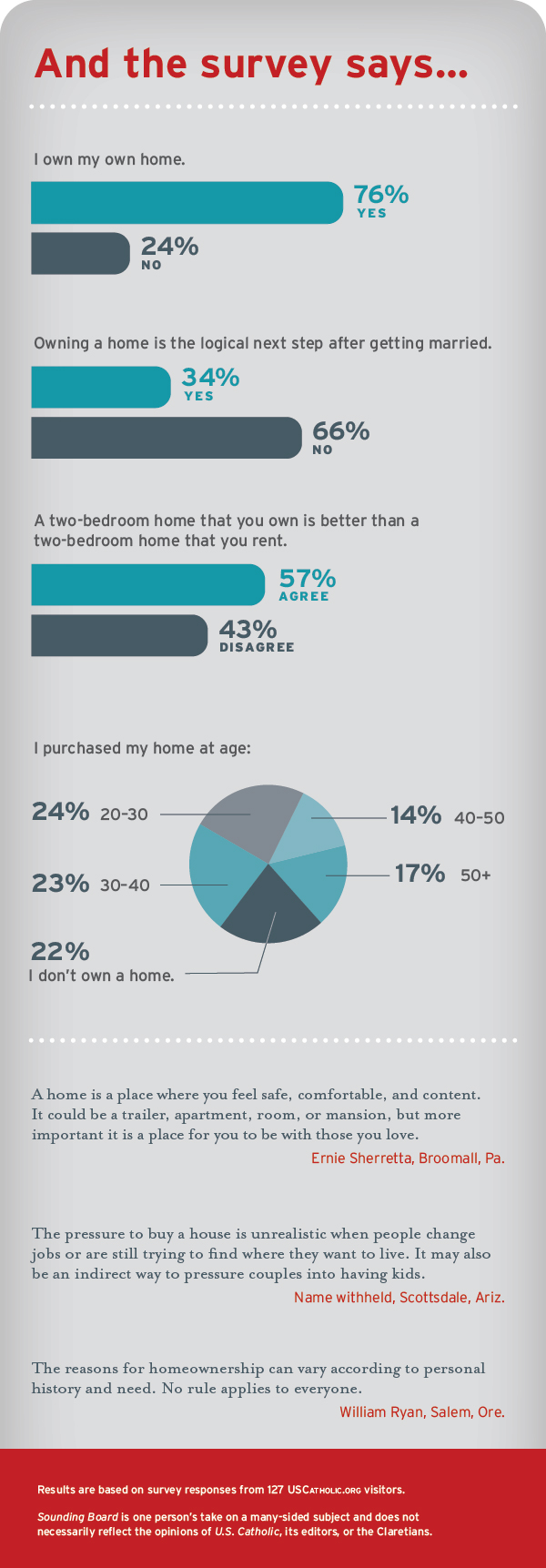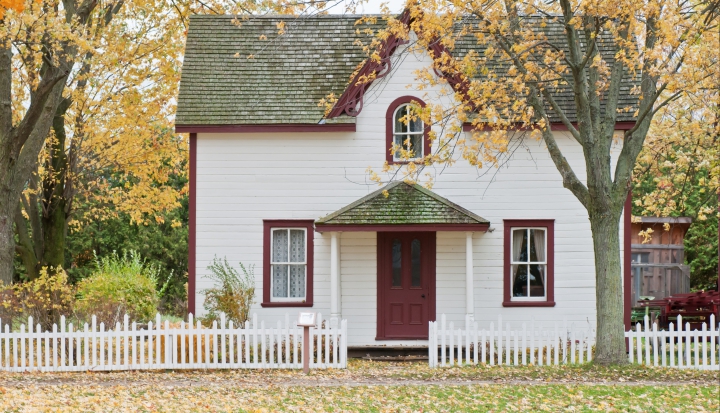“When are you guys gonna buy a place?” asked a couple sitting at a marriage prep retreat table with my fiancé and me. This was right after the priest leading the retreat told us to imagine what our future homes would look like. He provided most of the imagery for us (backyard, imaginary dog), and it all sounded quite similar to a cookie-cutter house I have seen on an episode of Leave It to Beaver.
The truth is my fiancé Jake and I have no idea when we’re going to buy a real home. Or even if we’re going to buy one at all. And, let me tell you, no one is satisfied with this answer.
So to appease inquisitive family and friends and strangers, we have had to develop some more satisfying stock responses. “Probably in two years,” we say, which is loosely based on nothing. Sometimes we’ll throw in the name of a random suburb or neighborhood just to make people settle down a bit.
We have to choose our imaginary plans wisely, too, because it turns out that only some houses qualify as real homes. What does not qualify, you ask? Rental apartments, rental condos, owned condos. Even some modest homes get called “starter homes” and only sort of count.
My parents bought a real home for our family in the early 2000s. But before that, they rented. During those years I had a friend who lived in a new-construction house much larger than mine, and when she’d visit she’d rave about how she loved my home. “It’s so cozy!” she’d say. “Everyone’s always around!” I never understood how she could possibly find my parents’ two-bedroom home superior to her family’s brand new five-bedroom house. I had a great home life, but I so wanted my house to be as real as hers. I’d seen the Pottery Barn catalog houses, and hers looked just like it. But in my house she noticed not its dearth of granite countertops and en suite baths but rather its palpable warmth because of the people in it.
I wish more people would think about homes this way. But many of us are caught up in HGTV’s house-flipping fantasy loop, and we can’t look away. I mean this literally—in 2016 HGTV was the third most-watched cable network, right behind Fox News and ESPN. Turns out everyone’s fantasizing about real homes.
To be truthful, I have always imagined my future real home to be a sort of Colonial Revival-style residence that features various elements of all the homes featured in John Hughes movies. These include but are not limited to: laundry chutes, lawn jockey statues, and monogrammed door knobs. But right now I live in a studio apartment in a 53-story high rise that is not in Kevin McCallister’s neighborhood.
Let me be clear: I would love to live in Kevin McCallister’s five-bedroom home. (The infamous Home Alone house is an actual house and costs nearly $2 million, by the way.) But Jake and I haven’t decided whether we would like to live in an apartment or a row house or in a city or a suburb. And this makes everyone around us a little nervous.
Why would we continue to rent when we could have a yard for the kids we don’t have yet, the dog we won’t have ever? Why would we waste money on rent when we could be pouring our money into something we own, which we can later sell and make even more money from? These are the kinds of things people like to ask us.
Despite there being benefits to homeownership (consistency, privacy, equity, tax deductions, the freedom to put holes in the walls), Jake and I would like some time to mull things over because, despite the pretty reclaimed wood picture HGTV’s Chip and Joanna Gaines like to paint, homeownership doesn’t always pay off, and it isn’t always for the right reasons.
Rich Dad Poor Dad author Robert Kiyosaki writes that one of the biggest “Rich Dad Scams” of all time is the notion that a home is an asset when it’s really a liability. “If you have a house, paid for or not, that you live in, then it can’t be an asset,” he writes. “Instead of putting money in your pocket, it takes money out of your pocket.”
This “scam” was prevalent when Kiyosaki wrote his book in 1997, when home values were climbing. “It was easy to assume that your house was an asset because it was potentially making money for you in the long run through appreciation,” he writes on his website. “People bought into the scam hook, line, and sinker, taking out home equity loans to buy cars, vacations, TV’s, and more. Today, those same people are so underwater that many of them are defaulting and going into foreclosure. Most people aren’t saying their home is an asset any longer.”
There may certainly be a point in time when Jake and I feel like accepting the liability for what it is. I like browsing the Pottery Barn catalog just as much as the next guy. I like to dream. But if Jake and I consider buying a home, we want to keep in mind the wisdom of my wise-beyond-her-years childhood friend—that a real home doesn’t have anything to do with whether it’s owned or rented, a two-bedroom apartment or a five-bedroom Colonial.
And the church shouldn’t perpetuate cookie-cutter homeownership fantasies either, even in jest at a marriage retreat. Want to raise all your kids in a two-bedroom apartment? Go ahead. Think you can afford the John Hughes movie house I have in mind? Go for it. But the kids who live with their parents in the rental apartment deserve a reminder that their house is a real home, too—even without the picket fence.

This article also appears in the February 2018 issue of U.S. Catholic (Vol. 83, No. 2, pages 34–37).
Image: Unsplash via Scott Webb












Add comment